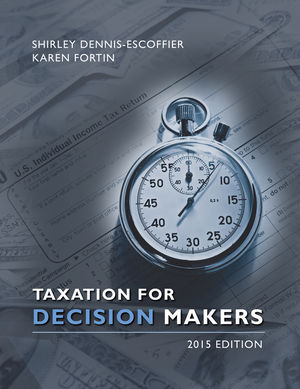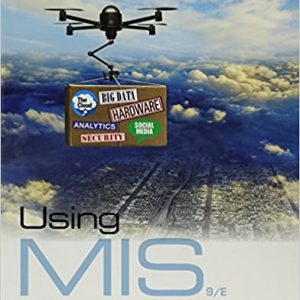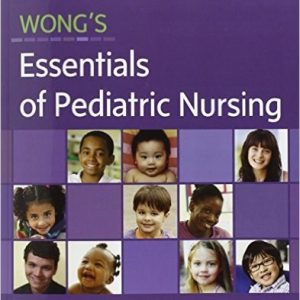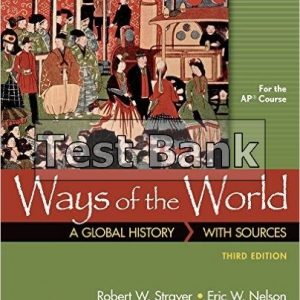Instant download Test Bank for Taxation for Decision Makers, 2015 Edition, Shirley Dennis-Escoffier, Karen Fortin pdf docx epub after payment.
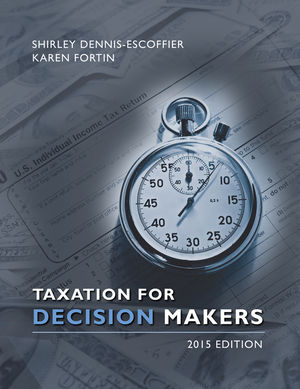
Product details:
- ISBN-10 : 1118947207
- ISBN-13 : 978-1118947203
- Author: Shirley Dennis-Escoffier; Karen Fortin
Taxation for Decision Makers, 2015 Edition is designed for a one-semester introductory tax course focused on decision-making at either the undergraduate or graduate level. The text introduces all relevant tax topics covered on the CPA exam in twelve chapters, and strikes a balance between concepts and technical details without overwhelming the student with seldom-encountered technicalities. The importance of tax planning is also emphasized throughout the text and is woven into each chapter with margin icons highlighting planning opportunities.
Table Of Contents:
About the Authors xxv
Part I Introduction to Taxation and Its Environment
1 An Introduction to Taxation 2
Setting the Stage—An Introductory Case 3
1.1. An Introduction to Taxes 3
1.1.1. What Is a Tax? 3
1.1.2. Evolution of the Federal Income Tax 4
1.1.3. State and Local Income Taxes 5
1.1.4. Employment Taxes 7
1.1.5. Wealth Taxes 8
1.1.6. Wealth Transfer Taxes 9
1.1.7. Consumption Taxes 10
1.1.8. Tariffs and Duties 12
1.2. Types of Tax Rate Systems 13
1.2.1. The Progressive Tax Rate System 13
1.2.2. Proportional “Flat” Tax Rate 15
1.2.3. Regressive Taxes 15
1.3. Characteristics of a Good Tax 16
1.3.1. Equity 16
1.3.2. Economy 17
1.3.3. Certainty 18
1.3.4. Convenience 18
1.4. The Taxing Units and the Basic Income Tax Model 19
1.4.1. The Basic Tax Model 20
1.4.2. Trusts and Estates 29
1.5. Choice of Business Entity 30
1.5.1. Sole Proprietorships 32
1.5.2. Partnerships 33
1.5.3. C Corporations 36
1.5.4. S Corporations 37
1.5.5. Comparing Business Entity Attributes 38
Revisiting the Introductory Case 40
Summary 40
Key Terms 41
Test Yourself 41
Problem Assignments 42
Answers to Test Yourself 46
2 The Tax Practice Environment 47
Setting the Stage—An Introductory Case 48
2.1. Tax Compliance 48
2.1.1. Filing a Tax Return 48
2.1.2. Selecting Returns for Audit 51
2.1.3. Types of Audits 52
2.1.4. The Appeals Procedure 53
2.1.5. Taxpayer Noncompliance Penalties 54
2.1.6. Collection Procedures 55
2.2. Professional Responsibilities and Ethics 56
2.2.1. Avoidance versus Evasion 56
2.2.2. Tax Preparer Registration 56
2.2.3. Tax Preparer Penalties 56
2.2.4. Tax Professionals’ Dual Responsibilities 57
2.2.5. Sources of Professional Guidance 58
2.3. Tax Planning 61
2.3.1. Cash Flows and Present Value 62
2.3.2. Significance of the Marginal Tax Rate 63
2.3.3. Timing Income and Deductions 63
2.3.4. Income Shifting 66
2.3.5. Changing the Character of Income 67
2.3.6. Other Factors Affecting Tax Planning 68
2.4. Tax Research 71
2.4.1. Gather the Facts and Identify the Issues 72
2.4.2. Locate Relevant Authority 72
2.4.3. Evaluate the Sources of Authority 79
2.4.4. Communicate the Recommendations 86
2.4.5. Keeping Up-to-Date 86
2.4.6. Sample Research Problem 87
Revisiting the Introductory Case 91
Summary 91
Key Terms 92
Test Yourself 92
Problem Assignments 92
Answers to Test Yourself 99
Appendix: Authorities for Sample Research Problem 99
Part II Income, Expenses, and Individual Taxes
3 Determining Gross Income 110
Setting the Stage—An Introductory Case 111
3.1. What Is Income? 111
3.1.1. Taxable versus Gross Income 112
3.1.2. Tax versus Financial Accounting 112
3.1.3. Return of Capital Principle 113
3.2. When Is Income Recognized? 114
3.2.1. The Tax Year 115
3.2.2. Accounting Methods 116
3.3. Who Recognizes the Income? 120
3.3.1. Assignment of Income Doctrine 120
3.3.2. Community Property Laws 120
3.4. Sources of Income 121
3.4.1. Interest Income 121
3.4.2. Dividend Income 126
3.4.3. Annuity Income 128
3.4.4. Transfers from Others 129
3.4.5. Discharge of Indebtedness 134
3.4.6. Tax Benefit Rule 135
3.4.7. System for Reporting Income 135
3.5. Exclusions 136
3.5.1. Gifts and Inheritances 136
3.5.2. Insurance Proceeds 137
3.5.3. Scholarships 139
3.5.4. Other Exclusions 140
3.6. Expanded Topics—Jurisdictional Issues 141
3.6.1. International Issues 141
3.6.2. Taxpayers Subject to U.S. Taxation 141
Revisiting the Introductory Case 144
Summary 144
Key Terms 145
Test Yourself 145
Problem Assignments 146
Answers to Test Yourself 154
4 Employee Compensation 155
Setting the Stage—An Introductory Case 156
4.1. Employee Compensation 156
4.1.1. Payroll Taxes 156
4.1.2. Employee versus Independent Contractor 158
4.1.3. Timing of Compensation Deduction 161
4.1.4. Reasonable Compensation 161
4.2. Employee Fringe Benefits 163
4.2.1. Group Term Life Insurance Premiums 165
4.2.2. Health and Accident Insurance Premiums 166
4.2.3. Child and Dependent Care Programs 167
4.2.4. Cafeteria Plans and Flexible Spending Arrangements 167
4.2.5. No-Additional-Cost Services 169
4.2.6. Employee Purchase Discounts 169
4.2.7. Employee Achievement Awards 170
4.2.8. De Minimis Fringe Benefits 170
4.2.9. Working Condition Fringe Benefits 171
4.2.10. Education Expenses 173
4.2.11. Employee Relocation Expenses 174
4.2.12. Substantiating Business Expenses 175
4.3. Employee Stock and Stock Options 176
4.3.1. Restricted Stock 176
4.3.2. Stock Options 179
4.3.3. Phantom Stock and Stock Appreciation Rights 181
4.4. Deferred Compensation and Retirement Planning 182
4.4.1. Qualified Retirement Plans 182
4.4.2. Types of Retirement Plans 183
4.4.3. Contribution Limits 185
4.4.4. Nonqualified Deferred Compensation Plans 186
4.4.5. Individual Retirement Accounts 187
4.5. Self-Employed Individuals 190
4.5.1. Employment Tax Consequences 190
4.5.2. Fringe Benefits Limited 192
4.5.3. Retirement Plans 193
4.6. Expanded Topics—Foreign Assignments 194
4.6.1. Foreign Earned Income Exclusion 194
4.6.2. Excess Housing Cost Exclusion 196
4.6.3. Credit for Foreign Taxes 196
4.6.4. Tax Reimbursement Plans 197
4.6.5. Tax Treaties 197
Revisiting the Introductory Case 198
Summary 198
Key Terms 199
Test Yourself 200
Problem Assignments 201
Answers to Test Yourself 208
5 Deductions for Individuals and Tax Determination 209
Setting the Stage—An Introductory Case 210
5.1. The Individual Tax Model 210
5.2. Adjustments to Income 212
5.2.1. Student Loan Interest Deduction 213
5.2.2. Educator Expenses 214
5.2.3. Health Savings Accounts 214
5.2.4. Penalty on Early Withdrawal of Savings 215
5.2.5. Other Adjustments to Income 215
5.3. Standard Deduction 216
5.3.1. Standard Deduction Amounts 216
5.3.2. Married Filing Jointly 218
5.3.3. Surviving Spouse 218
5.3.4. Married Filing Separately 219
5.3.5. Head of Household 220
5.3.6. Single (Unmarried) Individual 221
5.4. Itemized Deductions 221
5.4.1. Medical Expenses 222
5.4.2. Taxes 223
5.4.3. Interest Expense 224
5.4.4. Charitable Contributions 227
5.4.5. Casualty Losses 230
5.4.6. Miscellaneous Itemized Deductions 231
5.5. Qualified Business Income Deduction 233
5.6. Dependents 235
5.6.1. Qualifying Child 235
5.6.2. Qualifying Relatives 236
5.7. Tax Credits 238
5.7.1. Credits versus Deductions 238
5.7.2. Child Tax Credit 238
5.7.3. Education Credits 239
5.7.4. Dependent Care Credit 241
5.7.5. Earned Income Credit 242
5.7.6. Excess Payroll Tax Withheld 243
5.7.7. Other Credits 243
5.8. Computing the Tax 244
5.8.1. Medicare Surtaxes 246
5.8.2. Alternative Minimum Tax 248
5.8.3. Other Taxes 252
5.9. Payment of Tax and Filing the Return 252
5.9.1. Payment of Tax 252
5.9.2. NOL 253
5.9.3. Who Must File a Return? 253
Revisiting the Introductory Case 258
Summary 259
Key Terms 259
Test Yourself 260
Problem Assignments 261
Answers to Test Yourself 271
Part III Business and Property Concepts
6 Business Expenses 274
Setting the Stage—An Introductory Case 275
6.1. Criteria for Deductibility 275
6.1.1. General Provisions for Trade or Business Expenses 275
6.1.2. Ordinary and Necessary 276
6.1.3. Contrary to Public Policy 277
6.1.4. Related to Tax-Exempt Income 278
6.1.5. Accrued to Related Party 278
6.1.6. Obligation of Another Taxpayer 278
6.1.7. Substantiation 279
6.2. Timing of Deductions 279
6.2.1. Accrual Method 280
6.2.2. Cash Method 280
6.2.3. Restrictions on Prepaid Expenses 282
6.2.4. Disputed Liabilities 283
6.3. Costs of Starting a Business 283
6.3.1. Business Investigation and Start-Up Expenses 283
6.3.2. Organization Costs 284
6.4. Operating Expenses 285
6.4.1. Business Meals and Entertainment 285
6.4.2. Travel and Transportation Expenses 286
6.4.3. Combining Business with Pleasure Travel 289
6.4.4. Bad Debt Expenses 291
6.4.5. Insurance Premiums 292
6.4.6. Interest Expense 292
6.4.7. Legal Expenses 293
6.4.8. Taxes 293
6.5. Limited Expense Deductions 294
6.5.1. Residential Rental Property 294
6.5.2. Home Office Expenses 297
6.5.3. Hobby Expenses 300
6.6. Expanded Topics—Book/Tax Differences 300
6.6.1. Accounting for Income Tax Expense 300
6.6.2. UNICAP Rules and Inventory 307
Revisiting the Introductory Case 309
Summary 311
Key Terms 312
Test Yourself 312
Problem Assignments 313
Answers to Test Yourself 323
7 Property Acquisitions and Cost Recovery Deductions 324
Setting the Stage—An Introductory Case 325
7.1. Capital Expenditures 325
7.1.1. Capitalize or Expense 326
7.1.2. Basis of Property 327
7.2. MACRS 330
7.2.1. Averaging Conventions 331
7.2.2. Year of Disposition 335
7.2.3. Alternative Depreciation System (ADS) 336
7.3. Special Expensing Provisions 337
7.3.1. Section 179 Expensing Election 337
7.3.2. Bonus Depreciation 339
7.4. Provisions Limiting Depreciation 341
7.4.1. Mixed-Use Assets 341
7.4.2. Limits for Passenger Vehicles 342
7.5. Depletion 344
7.6. Amortization 345
7.6.1. Research and Experimentation Expenditures 346
7.6.2. Software 347
Revisiting the Introductory Case 347
Summary 348
Key Terms 348
Test Yourself 348
Problem Assignments 349
Answers to Test Yourself 357
Part IV Property Dispositions
8 Property Dispositions 360
Setting the Stage—An Introductory Case 361
8.1. Determining Gain or Loss on Dispositions 362
8.1.1. Property Dispositions and Cash Flow 362
8.1.2. Types of Dispositions 363
8.1.3. Amount Realized 364
8.1.4. Realized versus Recognized Gain or Loss 365
8.1.5. Holding Period 365
8.1.6. Character of Gains and Losses 367
8.1.7. Mixed-Use Assets 369
8.2. Disposition of Capital Assets 369
8.2.1. The Capital Gain and Loss Netting Process 369
8.2.2. Tax Treatment of Net Capital Gains and Losses 371
8.3. Disposition of Section 1231 Property 377
8.3.1. Depreciation Recapture 378
8.3.2. Unrecaptured Section 1250 Gains for Individuals 381
8.3.3. Section 1231 Look-Back Rules 382
8.4. Mixed-Use Property 384
8.5. Special Rules for Small Business Stock 385
8.5.1. Losses on Section 1244 Stock 385
8.5.2. Section 1202 Gains on Qualified Small Business Stock 386
8.5.3. Comparison of Sections 1244 and 1202 387
8.6. Sale of Principal Residence—Section 121 388
8.6.1. Debt Reductions, Short Sales, and Foreclosures 391
8.7. Navigating Individual Capital Gains Tax Rates 391
8.7.1. Determining the Long-Term Capital Gains Tax Rate 392
8.7.2. Planning with Multiple Tax Rates 393
Revisiting the Introductory Case 394
Summary 395
Key Terms 396
Test Yourself 396
Problem Assignments 397
Answers to Test Yourself 406
9 Tax-Deferred Exchanges 407
Setting the Stage—An Introductory Case 408
9.1. Basics of Tax-Deferred Exchanges 408
9.1.1. Basis Adjustments 409
9.1.2. Holding Period 410
9.2. Like-Kind Exchanges—Section 1031 410
9.2.1. Qualifying Properties 411
9.2.2. Determining Realized Gain or Loss and the Effect of Boot 411
9.2.3. Basis and Holding Period of Like-Kind Property 413
9.2.4. Indirect Exchanges 414
9.3. Involuntary Conversions 415
9.3.1. Casualty and Theft Losses 415
9.3.2. Gains on Involuntary Conversions—Section 1033 421
9.3.3. Involuntary Conversion of a Principal Residence 424
9.4. Other Tax-Deferred Exchanges or Dispositions 424
9.4.1. Wash Sales 424
9.4.2. Installment Sales 425
9.4.3. Related-Party Sales 426
9.4.4. Other Deferrals 428
9.5. Asset Transfers to Businesses 428
9.5.1. Transfers to Sole Proprietorships 428
9.5.2. Transfers to Controlled Corporations—Section 351 429
9.5.3. Transfers of Property to a Partnership 434
9.5.4. Formation of a Limited Liability Company 437
9.6. An Introduction to Corporate Reorganizations 437
Revisiting the Introductory Case 438
Summary 438
Key Terms 439
Test Yourself 439
Problem Assignments 440
Answers to Test Yourself 449
Appendix: Corporate Reorganizations 450
Part V Business Taxation
10 Taxation of Corporations 458
Setting the Stage—An Introductory Case 459
10.1. Introduction to Corporations 459
10.1.1. Corporate Advantages 460
10.1.2. Disadvantages of the Corporate Form 461
10.1.3. Capital Structure 461
10.2. Taxation of C Corporations 463
10.2.1. Dividend Received Deduction 463
10.2.2. Charitable Contribution Deduction 464
10.2.3. Capital Gains and Losses 465
10.2.4. Net Operating Losses 466
10.2.5. Computing the Corporate Income Tax 466
10.2.6. Reconciling Book and Taxable Income 467
10.2.7. Tax Credits 471
10.2.8. Filing and Payment Requirements 472
10.3. Corporate Dividend Distributions 472
10.3.1. Tax Effects of Dividend Distributions 473
10.3.2. Calculating Earnings and Profits 473
10.3.3. Applying E&P to Distributions 474
10.3.4. Property Distributions 477
10.3.5. Stock Dividends 478
People also search:
taxation for decision makers, 2015 edition
taxation for decision makers, 2015 edition pdf
taxation for decision makers
taxation for decision makers answer key

